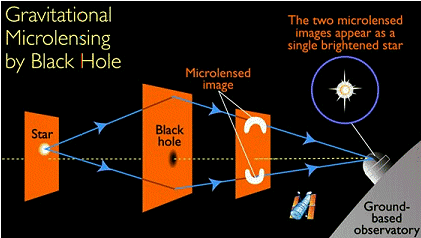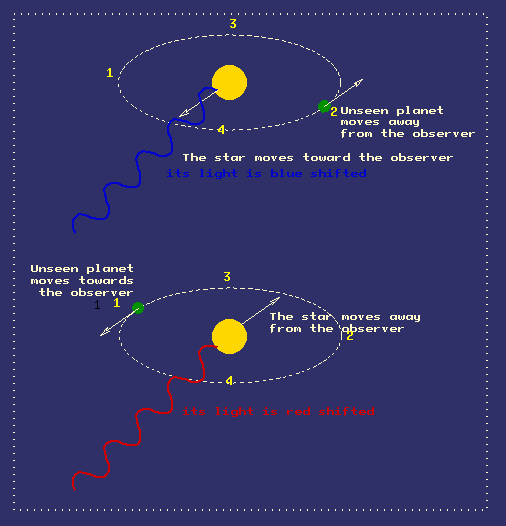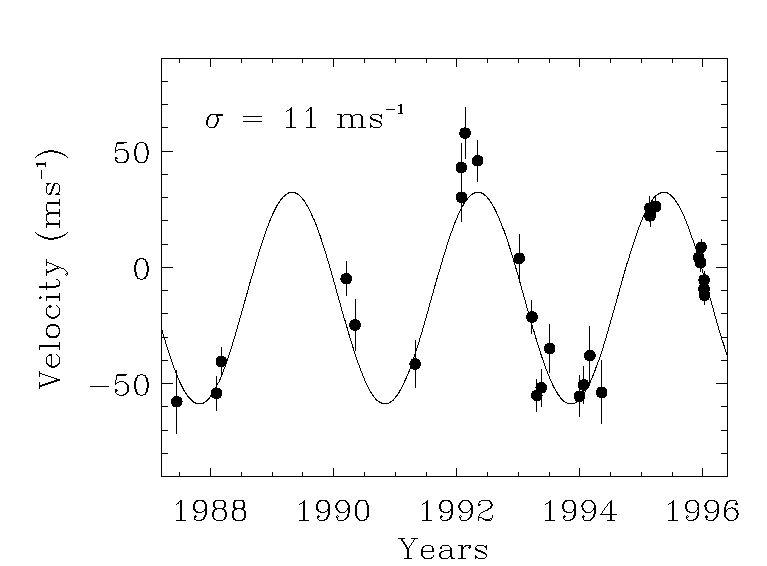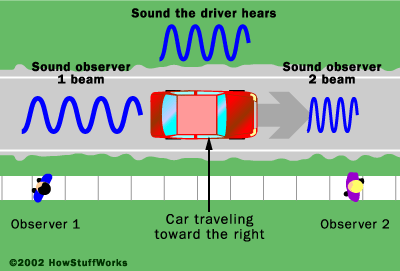
For intelligent life to exist in the Universe, stable planets must exist.
Over the last 8 years, substantial progress has been made in detecting the existence of other solar systems beyond our own. As of November 2008, there are 329 known extrasolar planetary systems and more are being discovered each year at the rate of 50-100 per year. As of Feb 2013, there are 861 known individual planets.
Extrasolar Planetary Status in near Real Time
Example of a direct detection (rare)
As mentioned before, planetary formation will occur after there has been sufficient time for the Galaxy to be seeded with heavy elements created through the process of stellar evolution and supernova ejection.
Thus we expect to find planetary systems around stars that have been created within the last few billion years because in that case the protostellar cloud will have been enriched in heavy elements. This expectation is clearly borne out by the data:

The principle technique used to discover extrasolar planets is called the radial velocity variation technique or doppler wobble and it is the technique we will focus on. However, there are now other techniques that have become available and are now being put to use to find new planets. These new techniques include:
The principle problems with this method are:
However, in cases of good detections, very accurate measurements of the planetary mass can be done.
Limitations of this method are:
Another problem associated with this method is the fact that infrared light from Earth can cause interference in the observation of extra-solar planets, making the observed star and planet appear as an individual occurrence of light. This means this method is most useful when implemented by space telescopes. Still, five new planets have been detected and confirmed using these technologies.

This means that light from a very distant star could be bent by the gravitational field from a close star plus planets, achieving an effect of exaggerated brightness from an observer on Earth's point of view. Most of the time, this will be a transient effect because the stars are moving in relation to one another, making the star first appear to be gradually brightening, then becoming more faint. If a planet is in orbit around the star, its gravity will cause an additional light-bending effect, producing a short-lived spike in the brightness of the star.
Microlensing makes it possible to find the most distant, smallest planets that current technology allows. On the other hand, these events are rare and rely on the passage of one star directly in front of another from someone on Earth's perspective. Plus, they aren't repeatable; there is essentially only one chance to detect planets using this method. I n addition, the brightness increase will be small. For these reasons, only four confirmed extra-solar planets have been found using the Gravitational Microlensing method.
By far, the most success in the detection of exosolar planets comes from the Doppler Wobble effect:
Consider the case of our Sun and Jupiter. Jupiter is sufficiently massive that it actually exerts a small but noticeable gravitational tug on the Sun.
To an external observer, the Sun will be observed to have a small change in its radial velocity. For the mass of Jupiter and the distance between Jupiter and the Sun, the amplitude of this change in velocity of +/- 12 meters per second.
This is shown below. At position 1, the observed velocity of the sun will be +12 meters per second while at position 2 it will be -12 meters per second. At positions 3 and 4 the observed velocity will be zero, as there is no radial component to the motion of the star.

Observations of this system will then yield the following kind of radial velocity curve :

The amplitude of this curve depends upon the mass and separation from the star of the perturbing planet. The period of the curve is the orbital period of the planet.
In this particular case, the orbital period is about 3 years and many orbital periods have been detected.
The shift in radial velocity is due to the well known doppler effect . This effect occurs for motion along the line of site (this is what we call radial motion). Motion along the line of site towards and observer causes the wavelength to be compressed and the frequency to shift to higher values, while motion away form the observer cause the wavelength to stretch and the frequency to lower.

Therefore, if we can monitor nearby stars for radial velocity variations at the level of a few meters per second, then we can potentially detect Jupiter mass planets in orbit about them.
Until recently, however, this was easier said than done.
To produce a detection, precision radial velocity observations are needed. Until about 1990, this was not possible with instrumentation. For instance, the typical precision was +/- 25 meters per second, and such an instrument clearly would not detect a system like Jupiter and our Sun.
In addition, one generally needs to observe a full orbital cycle to be sure that you have detected the presence of a perturbing planet.
So, for instance, even an external observer was monitoring the radial velocity variation of our Sun over a 6 month period, they would not be able to detect the presence of Jupiter, since its orbital period is 5 years.
The Press Release Race
Finding bonafide evidence of another planet in orbit about a nearby star would be a big deal. In fact, it wasn't until 1995 that this discovery was made.
Laptop exercise: This exercise is designed to simulate the scientific process behind this initial discovery. Please pay attention
Notice that the white line does seem to fit the data quite well. This is your detection. So now click on the publish to global view button to publish your detection.
When everyone has done this we can proceed with the exercise.